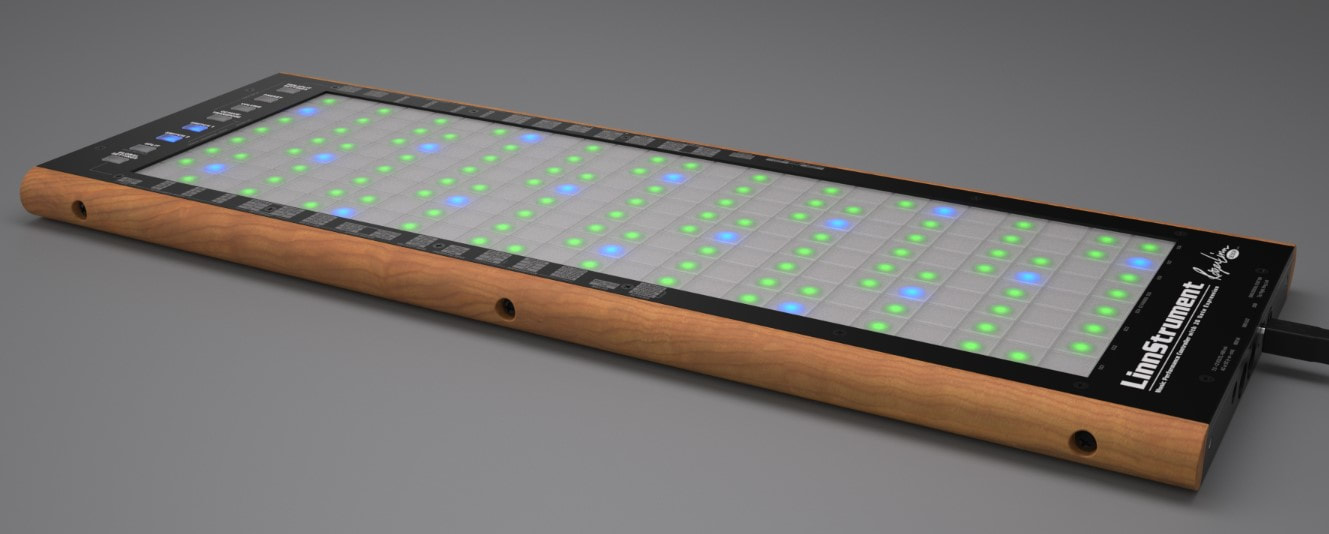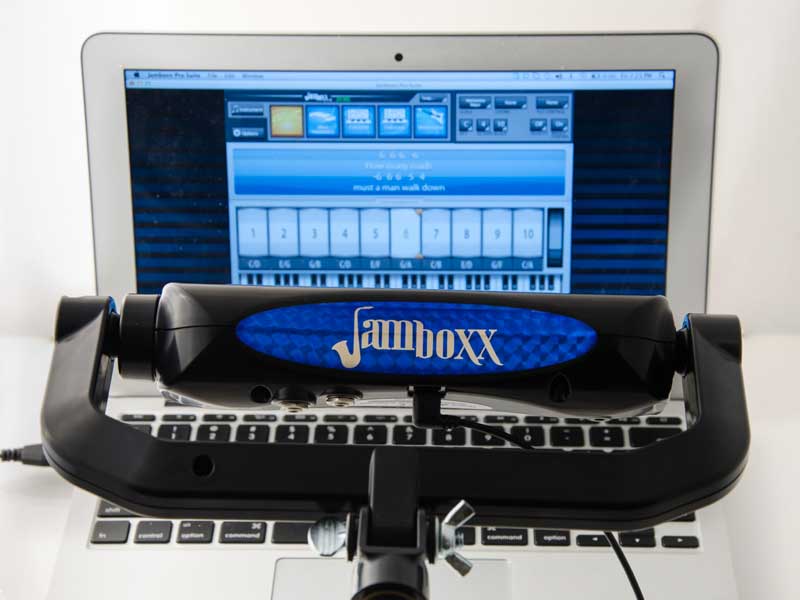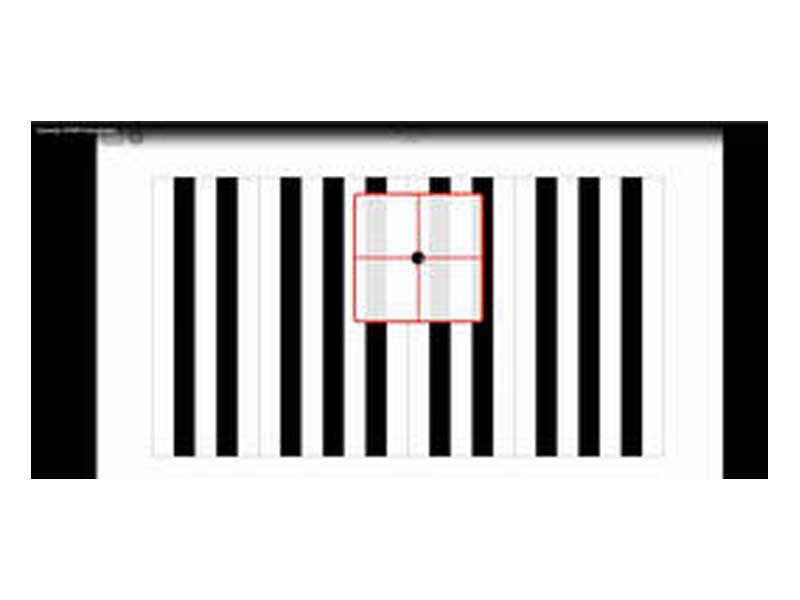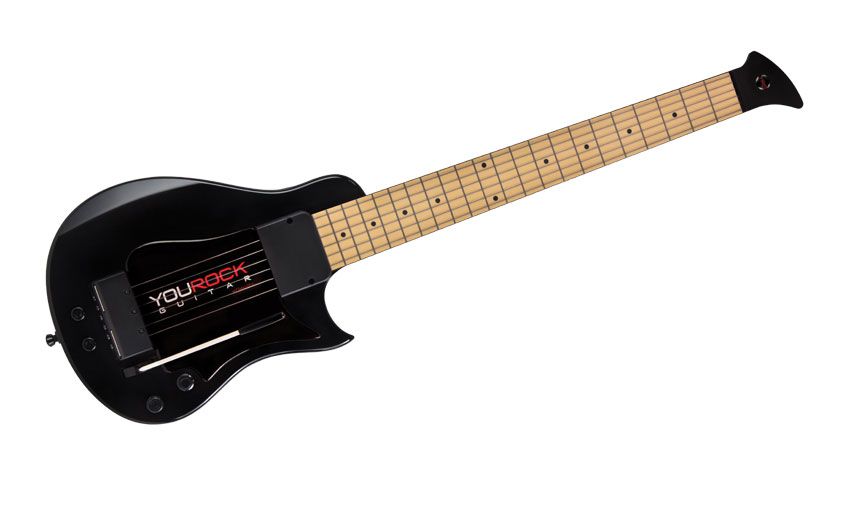Electronic InstrumentsElectronic instruments and enabling equipment made possible by the OHMI Competition or an OHMI commission.
|
The LinnStrument
|
The LinnStrument, created by Roger Linn, is an expressive alternative to the MIDI keyboard controller. It does not generate any sounds but rather sends standard MIDI messages over its MIDI or USB jacks to any MIDI sound generator or software. But that's where the similarity ends. Unlike a MIDI keyboard's simple on/off switches, LinnStrument's patent-pending multi-touch technology captures three dimensions of each finger's movement, polyphonically, for a far greater degree of musical expression than can be achieved on a MIDI keyboard. In addition to providing standard strike velocity, typically finger pressure (Z axis) is used to vary note loudness, finger left-right (X axis) movement is used to vary pitch, and finger forward-backward (Y axis) movement is used to vary timbre. Also unlike a MIDI keyboard, LinnStrument's notes are arranged not as on a piano, but rather like any stringed instrument, with multiple rows (strings) consisting of 2 octaves of semitones each. The rows can be tuned as a guitar, in fifths as a violin or cello, in fourths, or any interval you like. All this adds up to an electronic instrument with expressive control approaching that of fine acoustic instruments, allowing you to develop subtle musical gestures and a personal playing style, just as great musicians have done in past on acoustic instruments.
*** Roger generously offers a 20% discount to any disabled musicians who are interested in purchasing a LinnStrument. Please see here for more details.*** |
P-bROCK Digital Bagpipe Chanter
|
The P-bROCK Digital Bagpipe Chanter is an electronic instrument, developed by Duncan Menzies at Queen Mary University of London, to assist in the teaching and learning process of the Great Highland Bagpipe. This instrument presents a custom fingering algorithm to allow the instrument to be played by musicians with the use of only one hand.
The chanter features infra-red reflectance sensors, mounted inside the tone holes to detect the player’s finger movements, and an air pressure sensor in place of the chanter reed to measure air flow. Since all of the electronics are built into a standard acoustic chanter, and the tone hole sensors measure coverage of the actual holes by the player’s fingers, the physical playing experience is virtually indistinguishable from a traditional GHB chanter. |
Key WI
|
The goal of the KeyWI, created by Matthew Caren, is to have an electronic melodica-like wind instrument that offers the accessibility, expressiveness, and portability of the acoustic melodica but with the vastly increased flexibility and versatility of an electronic system. Like the traditional melodica, the KeyWI uses a piano keyboard as the basis of the control system, making it easily playable with one hand and accessible to the wide community of keyboard players, as well as allowing for intuitive polyphony. The KeyWI also mirrors the melodica’s compact size, making it extremely portable and giving keyboard players an instrument, they can take anywhere. The instrument is programmable, so new patches can be uploaded to enable the creation of a huge variety of sounds. Furthermore, the KeyWI aims to improve upon some limitations in electronic wind instruments compared to their acoustic counterparts — such as attack/transient response, breath sensor dynamic range, and nuances in breath pressure — while remaining as open-source as possible.
|
Jamboxx
|
The Jamboxx is a hands-free, breath-activated electronic MIDI wind controller which can play an infinite range of sounds including those of traditional instruments, such as piano, guitar, saxophone, violin, bass and drums. It is suitable for the novice as much as for accomplished musicians. With no key fingerings and the ability to pre-set your own key tunes, it can be learned in seconds. It can also be adapted for different ranges of breath capacity as well as for different ranges of head motion. The instrument is very sensitive, such that even the slightest breath can trigger notes. By using the included bracket, the Jamboxx can be played hands-free. Moving the mouthpiece left and right selects the desired note. Puffing and sipping plays different notes, similar to a harmonica.
|
Bowed-String LinnStrument
|
Rishi Shukla has built on the previous success of the LinnStrument, but now, by reducing the complex set-up process to one single button - the on-off switch! Unlike the standard Linnstrument, it has no graphical user interface, and performance techniques will be readily understood by players of the traditional instrument – bowing, vibrato, tremolando, pizzicato, even subtle pitch manipulation, and all with a single hand. No “re-programming” of the device is involved. It permits expressive performance and allows learners to progress through traditional repertoire.
|
Clarion
|
The Clarion is a musical instrument interface, created by Barry Farrimond from Open Up Music, based upon a conventional keyboard layout, that can be navigated through mouse movement. A red circle follows the mouse across the screen, showing the musician her/his position. Using mouse movement as a means of navigation opens up access to musicians who are able to control a mouse with computer peripherals like Eyegaze, SmartNav or indeed one hand placed upon a track pad or mouse. Dynamics and expression can be controlled through various elements. On screen, when a note is triggered, a square pops up and remains visible until the note is released. Movement within this square is used to affect a range of musical parameters including vibrato intensity, vibrato rate, flutter tongue and growl. The Clarion has also been designed to work with MIDI breath controllers, providing real-time musical dynamics and expression.
|
Mi.Mu Tuba
|
The Mi.Mu musical data glove system has been developed and built over the past four years by Imogen Heap and a small team of musicians, engineers, and artists. The glove system combines state-of-the-art sensor technology with custom machine learning algorithms and mapping software to allow gestures to be easily mapped to musical parameters on a computer. This glove has been adapted by Kelly Snook for use with one hand, along with other (optional) parts of the body, and programmed with pre-existing music software to emulate the Tuba.
|
You Rock Guitar
|
The You Rock Guitar aka YRG Gen2 is a fast tracking no latency MIDI controller that was created as a means to input music through various software applications, external synth modules and virtual instruments. The YRG’s unique patented fingerboard technology has allowed users with disabilities to be able to access music they have been unable to do before. The You Rock Guitar is in a working environment with the organisation TERI, Inc who work with children and adults with Down Syndrome, Autism and other disabilities, as well as with Warrior Cry, an organisation that works with wounded veterans who have lost limbs and other debilitating issues.
|
Donate to OHMIThere are so many disabled people who are desperate to play music with their peers. We can help to make that happen – but we can only do that with the wonderful support of our funders and donors.
As our instruments have to be hand-made by experts, they can only be produced in small numbers and are therefore expensive. Every little really does help.
|
Contact usIf you have a query or wish to contact us, please use the contact form available here.
You can also write to us: The OHMI Trust, 29 Woodbourne Road, Harborne, Birmingham B17 8BY |
Subscribe to our NewsletterIf you would like to join our mailing list and keep up to date with the latest news, please complete the form available here.
|
Privacy and Cookies Notice | Complaints Policy
All content © OHMI - Enabling Music-Making for Physically Disabled People
The OHMI Trust is a registered charity (Registered in England and Wales Charity No. 1143623, Scotland Charity No. SC052047).
Registered office: 29 Woodbourne Road, Harborne, Birmingham, B17 8BY
All content © OHMI - Enabling Music-Making for Physically Disabled People
The OHMI Trust is a registered charity (Registered in England and Wales Charity No. 1143623, Scotland Charity No. SC052047).
Registered office: 29 Woodbourne Road, Harborne, Birmingham, B17 8BY












